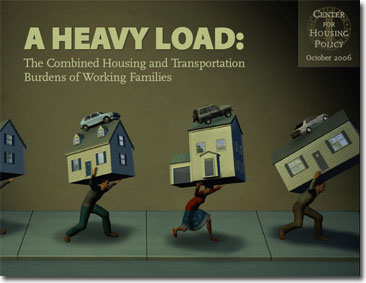Is your city a burden to creatives?

If it doesn’t have walkable urban neighborhoods, it could very well be. Based on a recent study, A Heavy Load: The Combined Housing and Transportation Burdens of Working Families by the Center for Housing Policy, in many ways for creatives, living in an auto-oriented small town is less affordable than subsisting in Manhattan.
The study covered low- to moderate-income (ie including artists, musicians, entrepreneurs just starting out) working families (married with and without children, single parents with children) across 28 major metropolitan areas nationwide. It found that combined transportation and housing costs were extremely constant, averaging 57% of annual income (with a low of 54% in Pittsburgh to a high of 63% in San Francisco.) However, among all household types of every income, those combined costs are only 48%, with just about all of the difference coming from transportation costs (see study table below).
 What does this help conclude? Creatives, the key to job growth in your city, will find ways to make housing affordable, attainable (ie smaller units, shared housing). However, in order to support the creatives in your city that are incubating potential fast-growth companies and cultural destinations, if you don’t have urban neighborhoods where owning a car is an option rather than a requirement, that’s an unnecessary financial burden that lessens the mystery of why so many creatives aspire to move to Manhattan, as profiled just previously.
What does this help conclude? Creatives, the key to job growth in your city, will find ways to make housing affordable, attainable (ie smaller units, shared housing). However, in order to support the creatives in your city that are incubating potential fast-growth companies and cultural destinations, if you don’t have urban neighborhoods where owning a car is an option rather than a requirement, that’s an unnecessary financial burden that lessens the mystery of why so many creatives aspire to move to Manhattan, as profiled just previously.

I think that this post kind of misses the point of the study. There is always so much focus on the walkable downtown; what about solid, walkable neighborhoods? Granted, there is a certain glamour to living in the center of the city, but creatives most often flock to peripheral neighborhoods, just outside of the downtown area, don’t they? Isn’t the best way to attract a large number of creative types to a city to offer them a wide range of dense, walkable, urban neighborhoods outside of downtown?
I agree Brendan. I amended the entry based on your comments. I was referring to ‘downtown’ much too loosely, as in terms of ‘not suburbia’, which is better described as ‘urban’.
How does a place like Austin fit into this? It’s often hailed as a haven for creatives, but it is a sprawling car city. There are a handful of walkable spots, but living carfree is not a realistic option for most.
You’re right Chris – Austin isn’t a great example for walkability, and not only do its city leaders acknowledge this, but they’re investing in changing it.
Overall though, Austin is a creative destination despite not excelling in place-making, and it had to have one of the largest universities in the world, one of the largest concentrations of high tech companies in the world, and a moniker worthy of being the live music capital of the world, plus being in Texas where a walkable urban environment doesn’t exactly fit in with the ‘bigger is better’ mentality.
Let’s just say Austin did it the hard way, but it’s getting easier each year to attract even more creatives. In other words, you ain’t seen nothing yet, and it’s a wise investment opportunity as far as urban real estate goes.
In your opinion where are the
creative cities that are walkable and afforable.
You mean in this country? Just kidding.
Based on the most sustainable, the least car-dependent, and the bohemian bargains, the big cities that most qualify would be Philly, Baltimore and Oakland. Not the most desirable right now, but that’s why they’re affordable, and they’re investing in the right things.
How about in other countries?